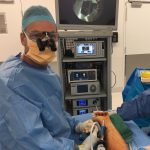Wrist Ganglions
Ganglions are jelly filled sacks, arising from collagen rich tissues such as ligaments or tendon sheaths. In the wrist they usually become obvious to patients in the form of a lump, on either the palmar or the dorsal (fingernail) side. They may be painless or painful, depending on their size and location, as well as on the patients activity level. Very commonly, the size of the ganglion will fluctuate with time.
Not all lumps around the wrist are ganglions, so it is important to be fairly sure of the diagnosis before giving advice. If a ganglion is large enough, it will light up when a torch is shined into it. In smaller ganglions, this is not reliable, and either an ultrasound or MRI is required to confirm the diagnosis. If the lump occurs in an unusual part of the wrist, then an MRI should be performed.

A volar wrist ganglion which had recurred after open excision – ready for arthroscopic decompression

View of ganglion jelly being decompressed into the joint during dry wrist arthroscopy.
Once the diagnosis of ganglion is clear, then the patient has the following options.
- Observation – this just means living with it. If it is not painful and not too unsightly, the patient may elect just to leave it alone.
- Aspiration – or sucking the jelly out through a needle. The chances of the ganglion refilling with jelly are high, about 85% or more. I rarely recommend this treatment.
- Surgery – in my hands, the most effective treatment for symptomatic wrist ganglions is arthroscopic ganglionectomy. Essentially, a wrist arthroscopy is performed, and the ganglion is decompressed into the inside of the wrist. There is minimal scarring, wrist motion is rapidly regained and the recurrence rate is the same as after open surgery – about 10%.
The main reasons to perform surgery are associated pain or a large size interfering with wrist motion.


